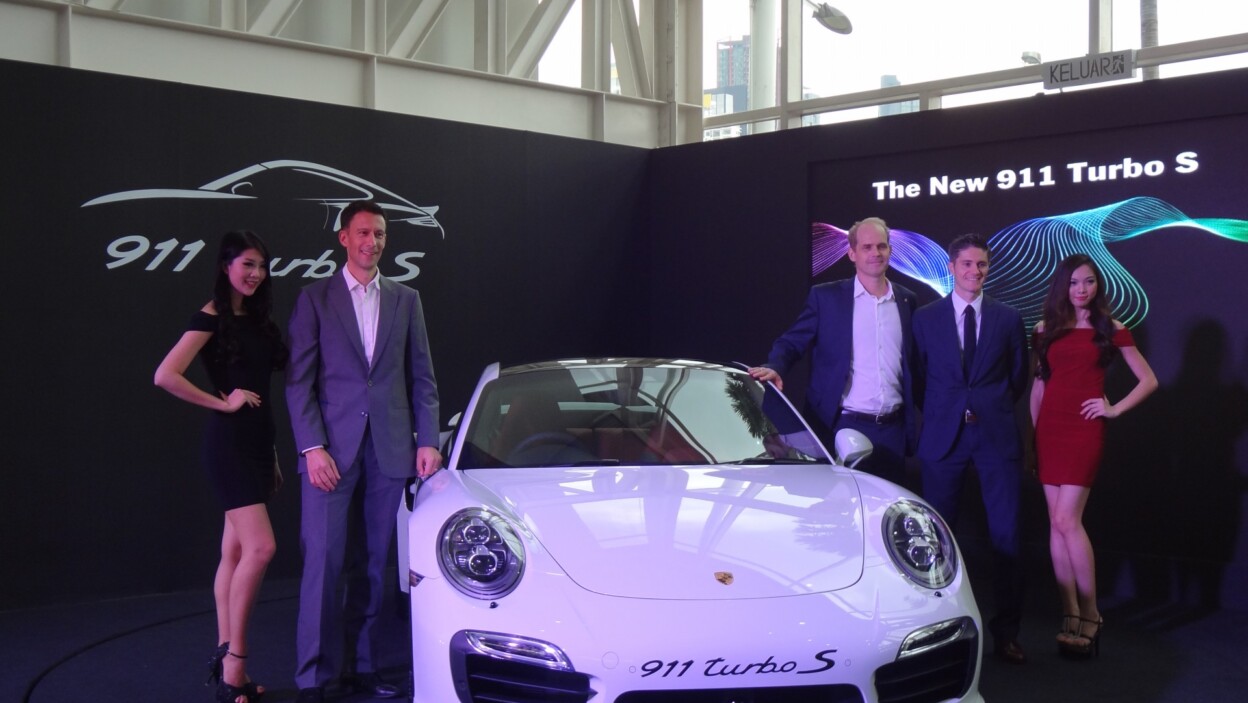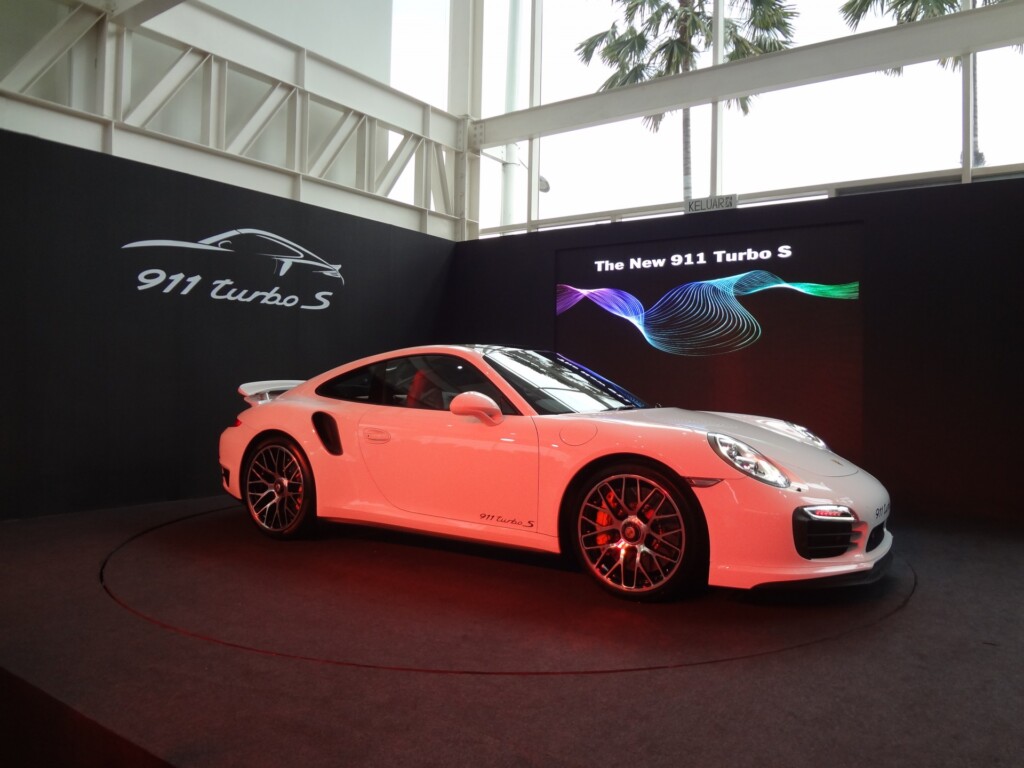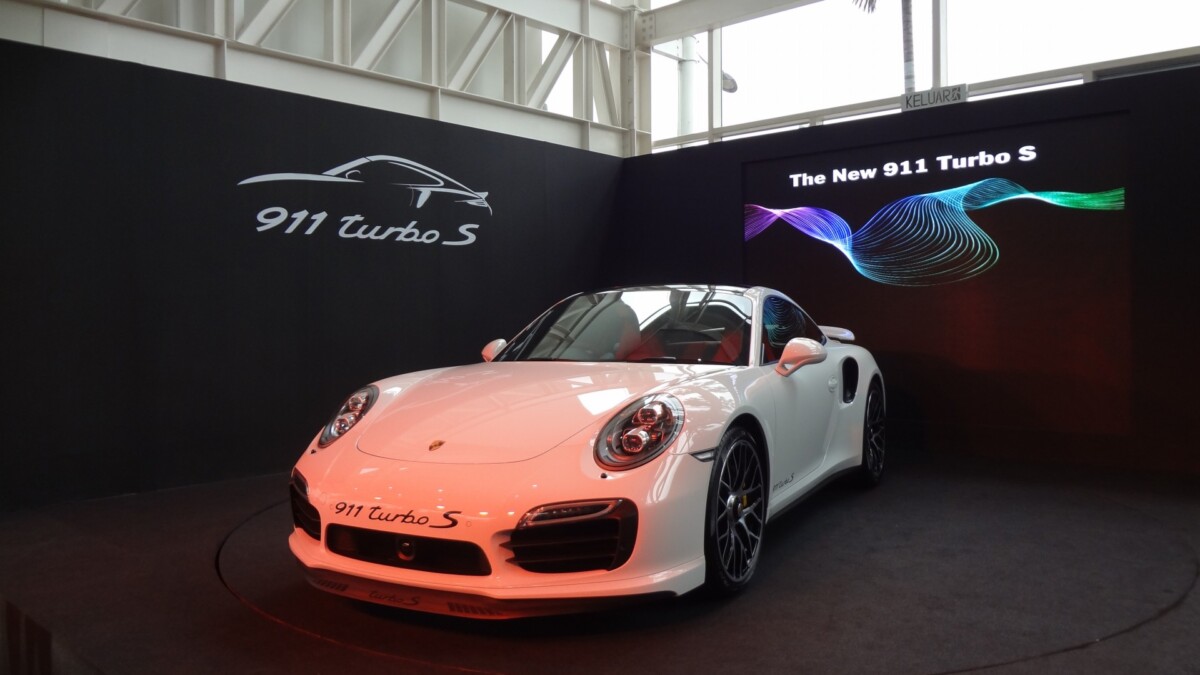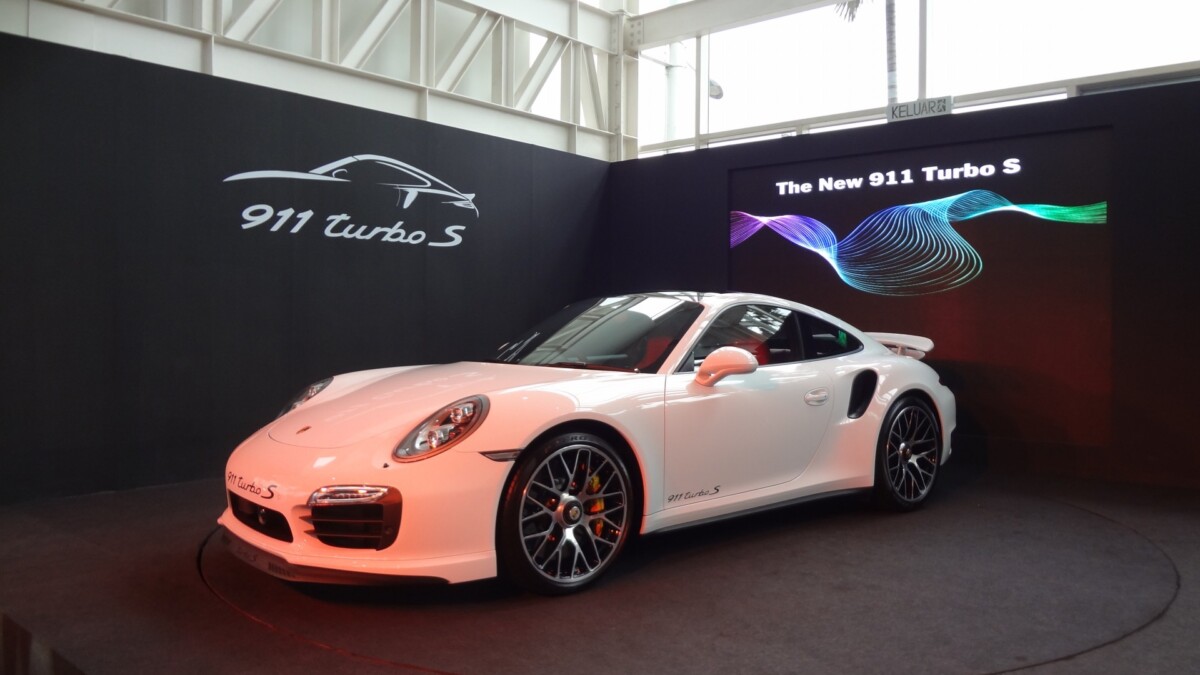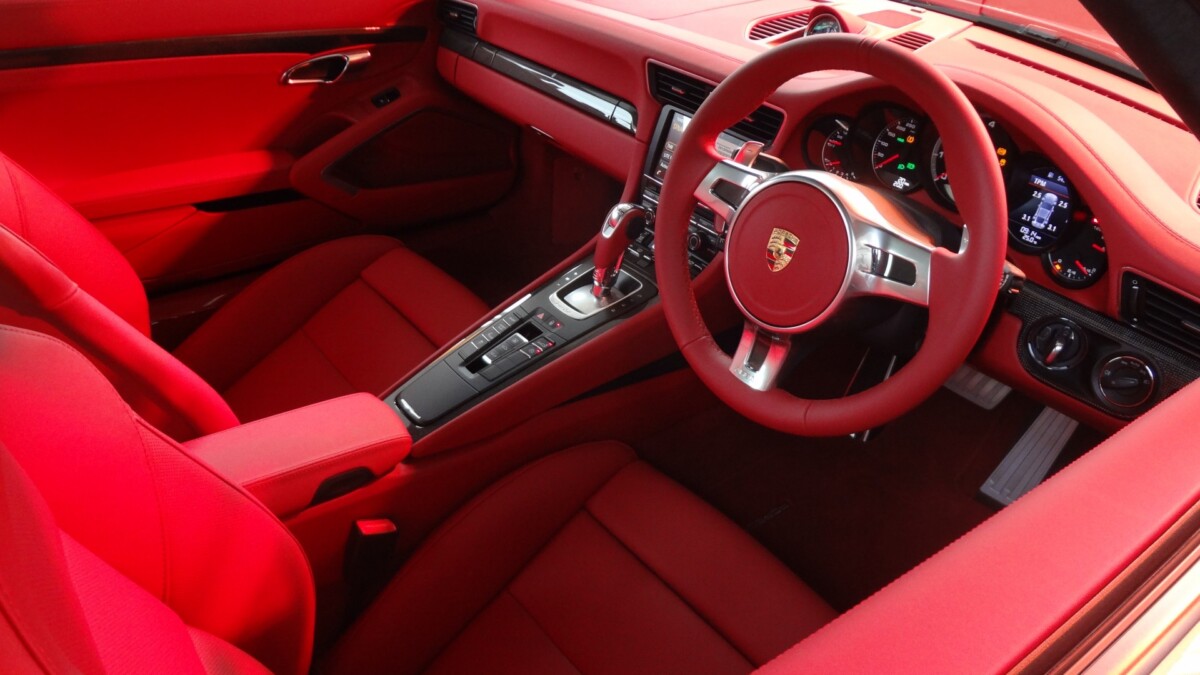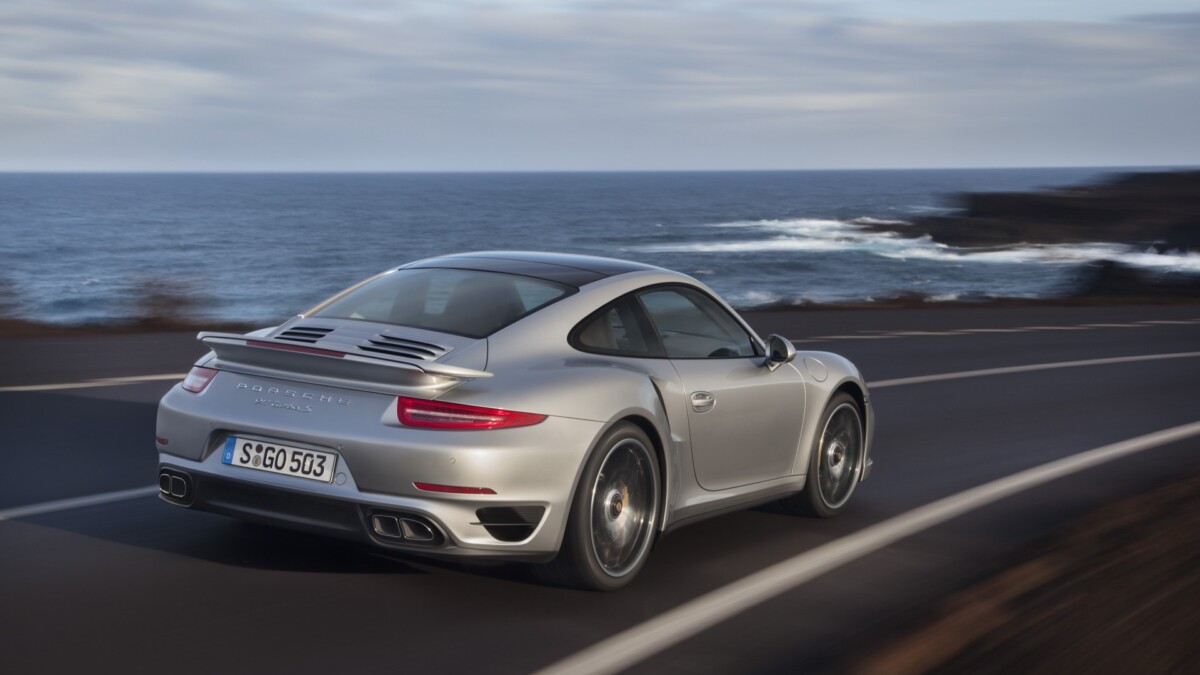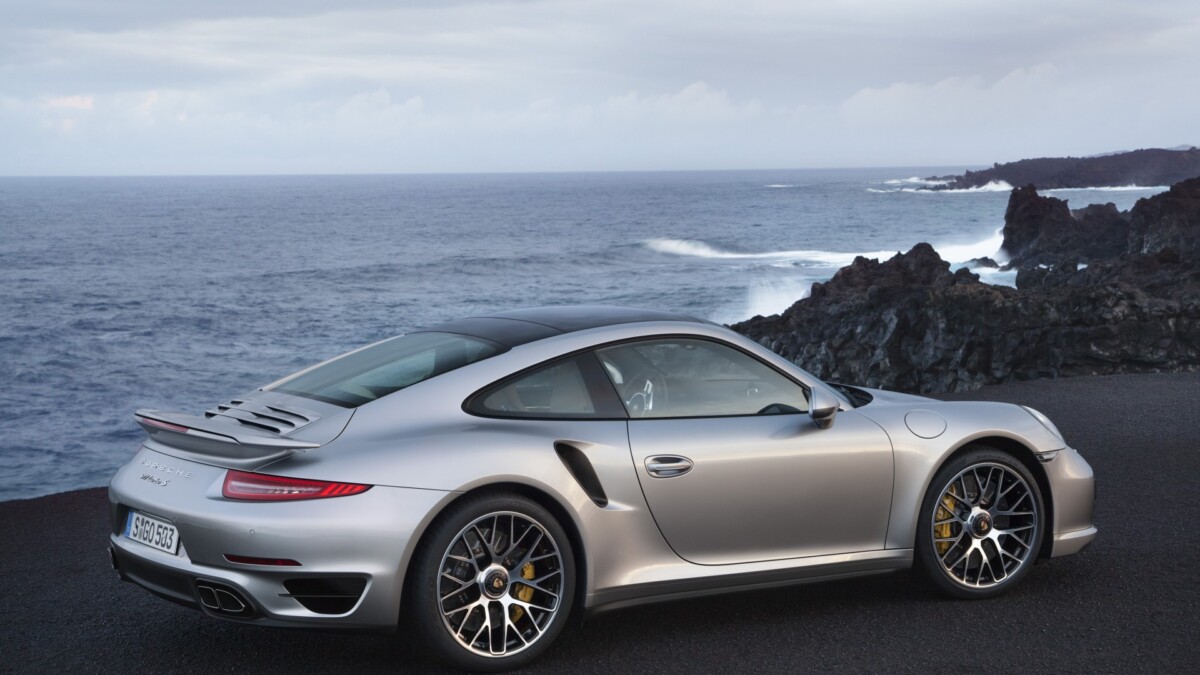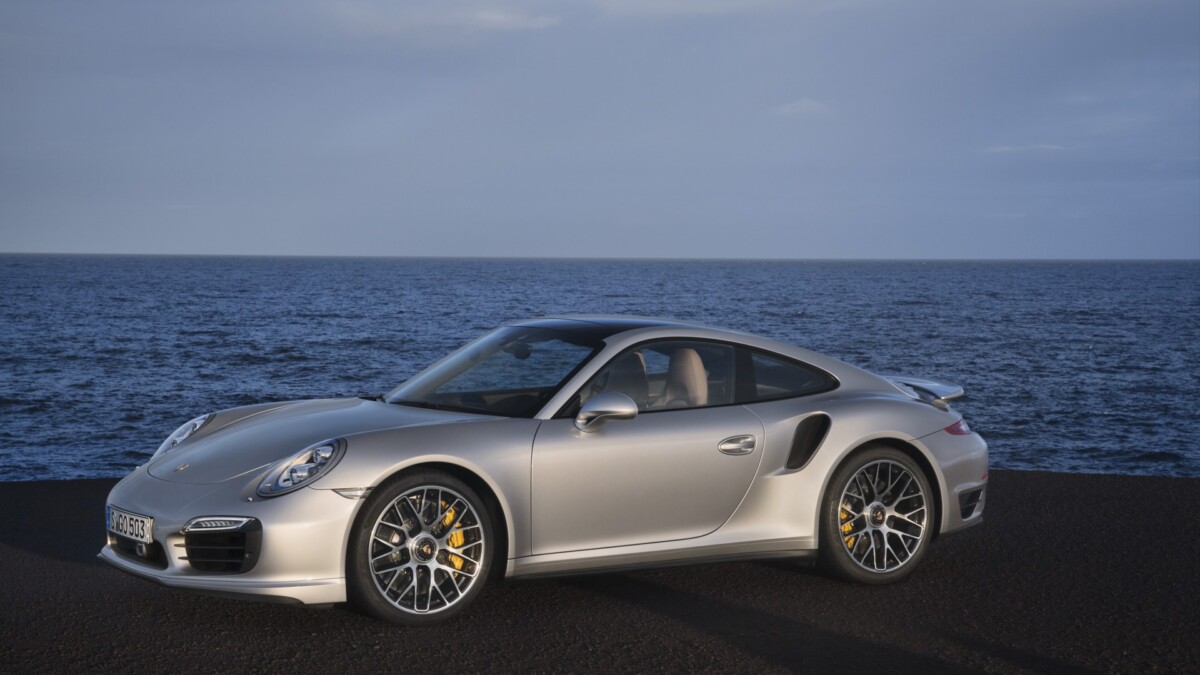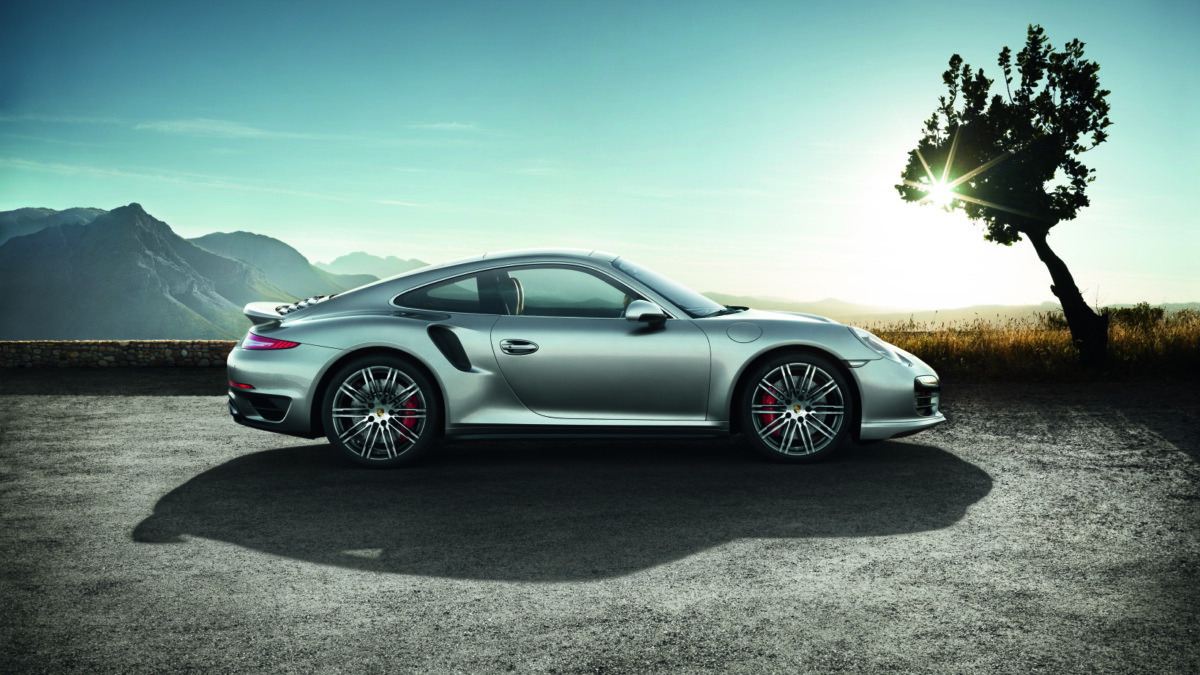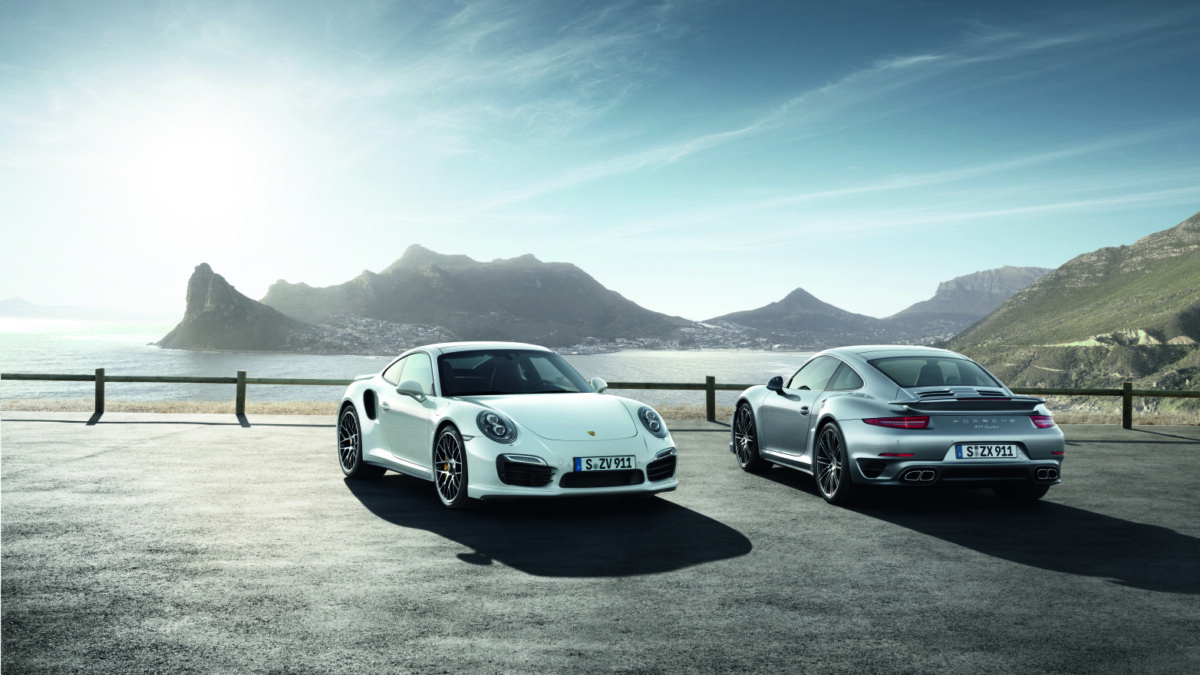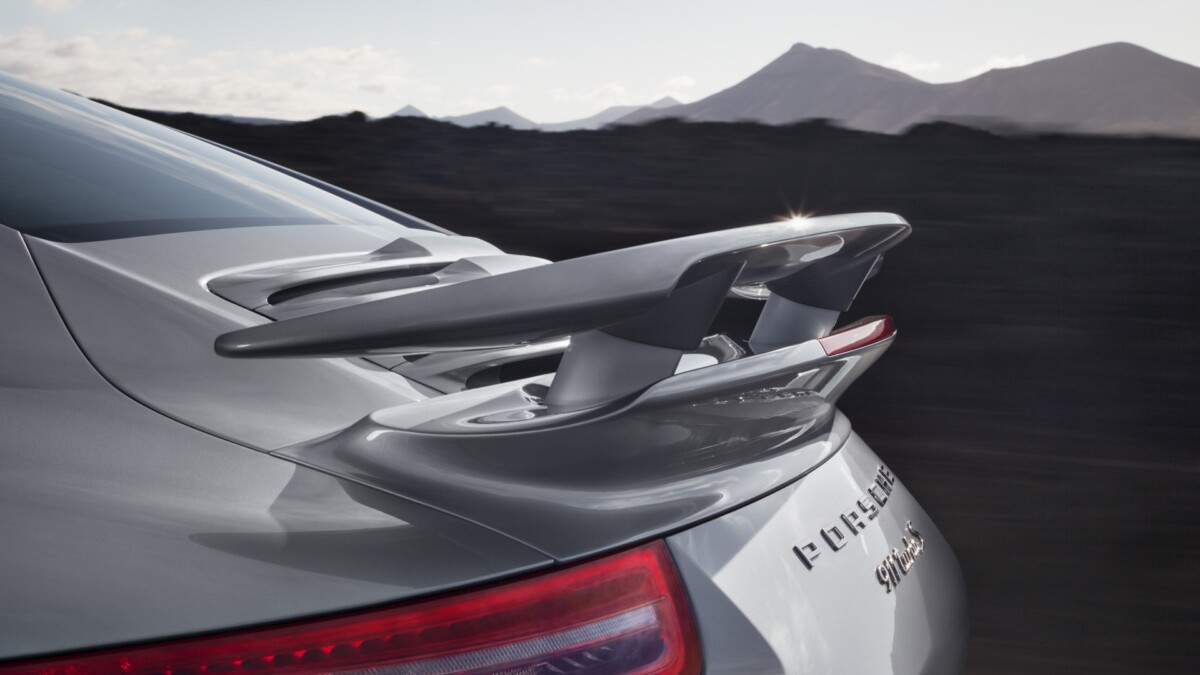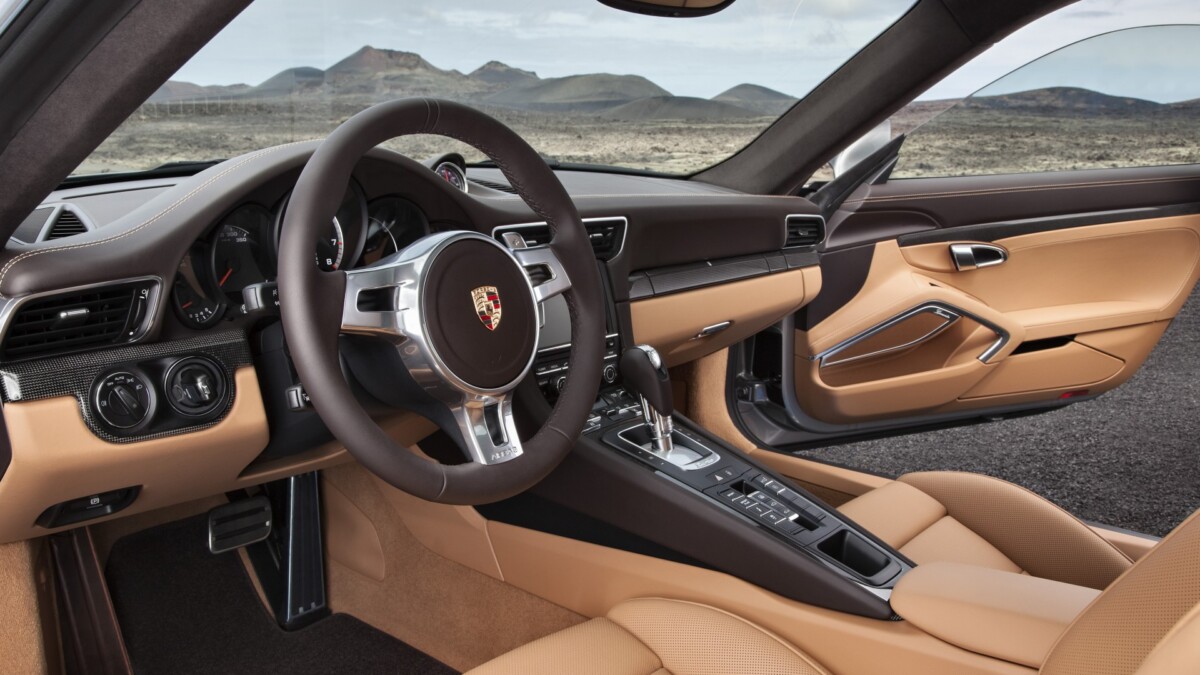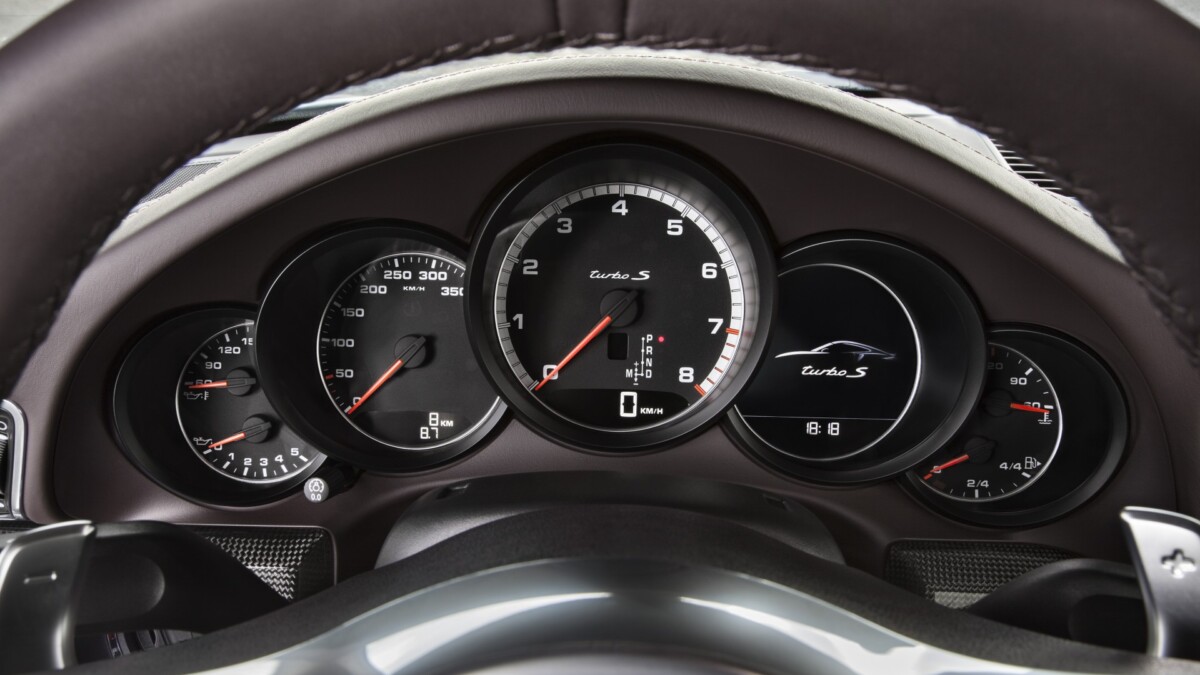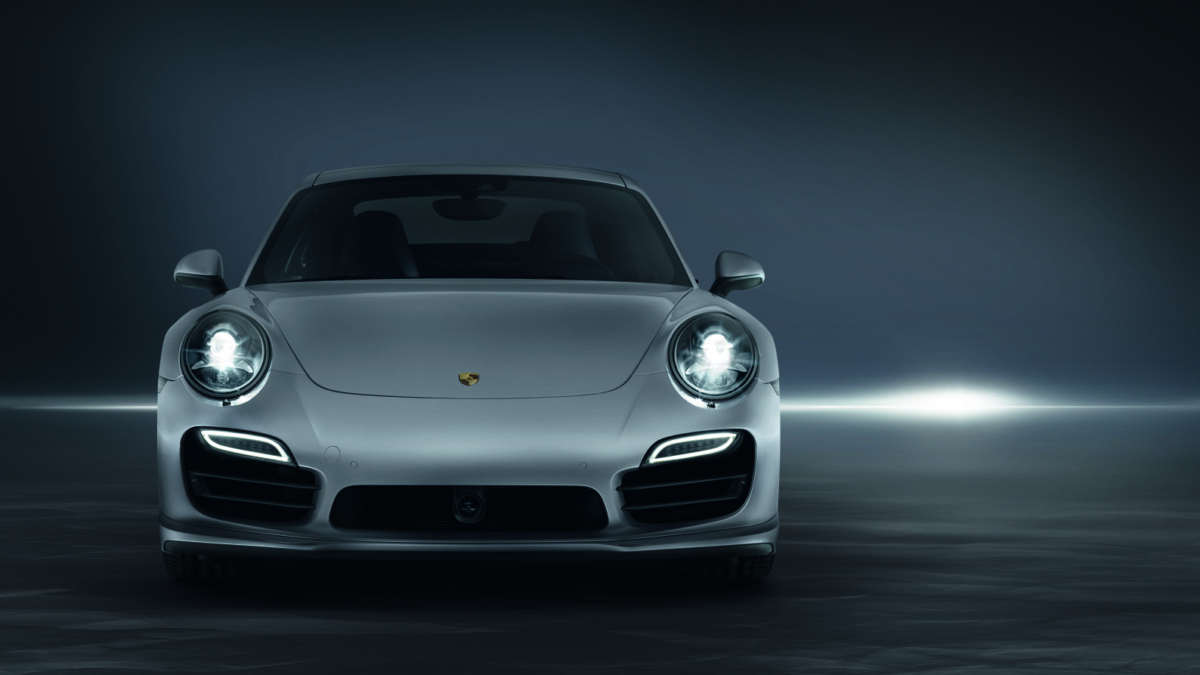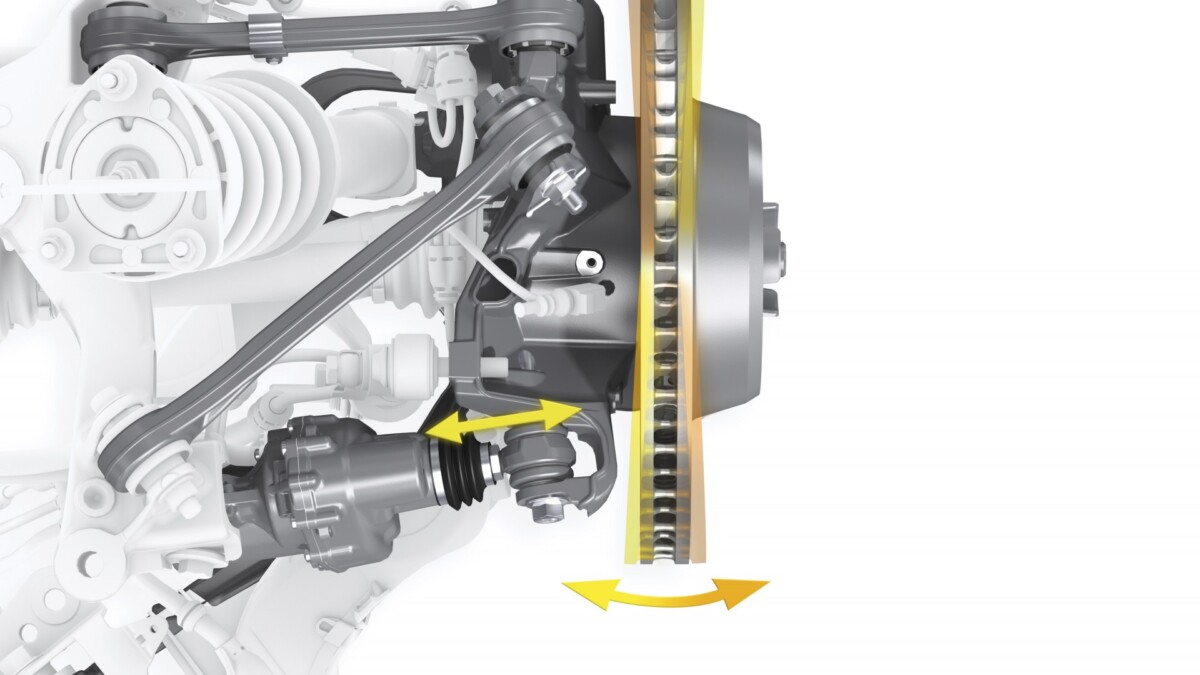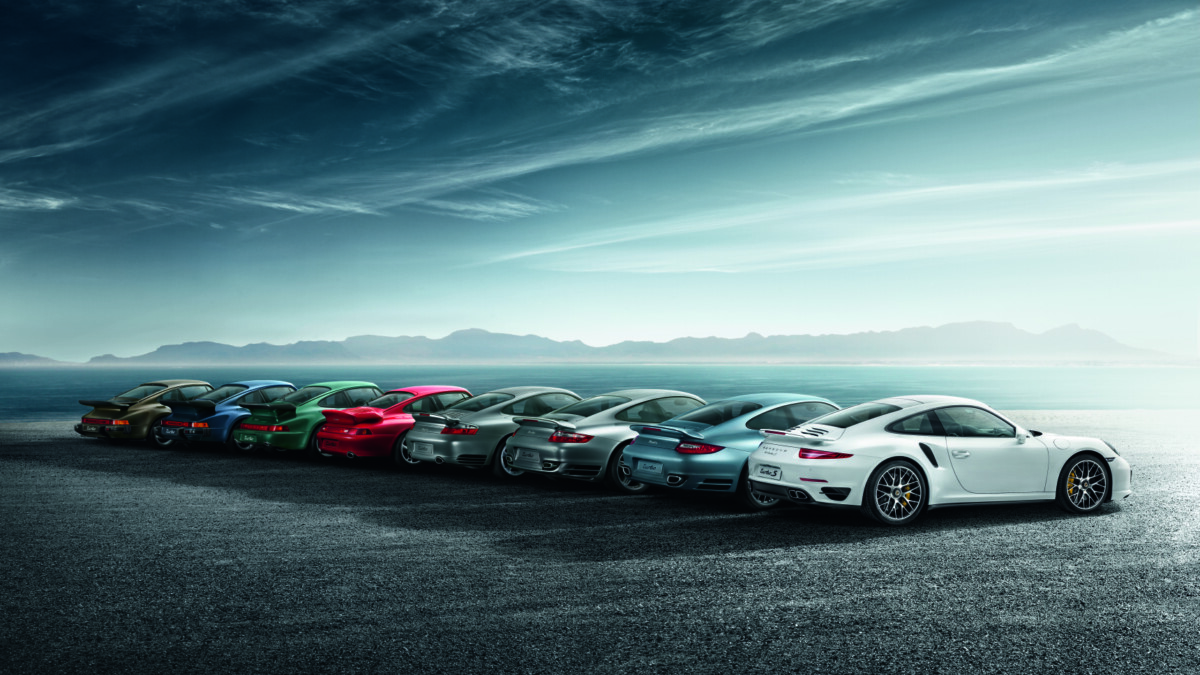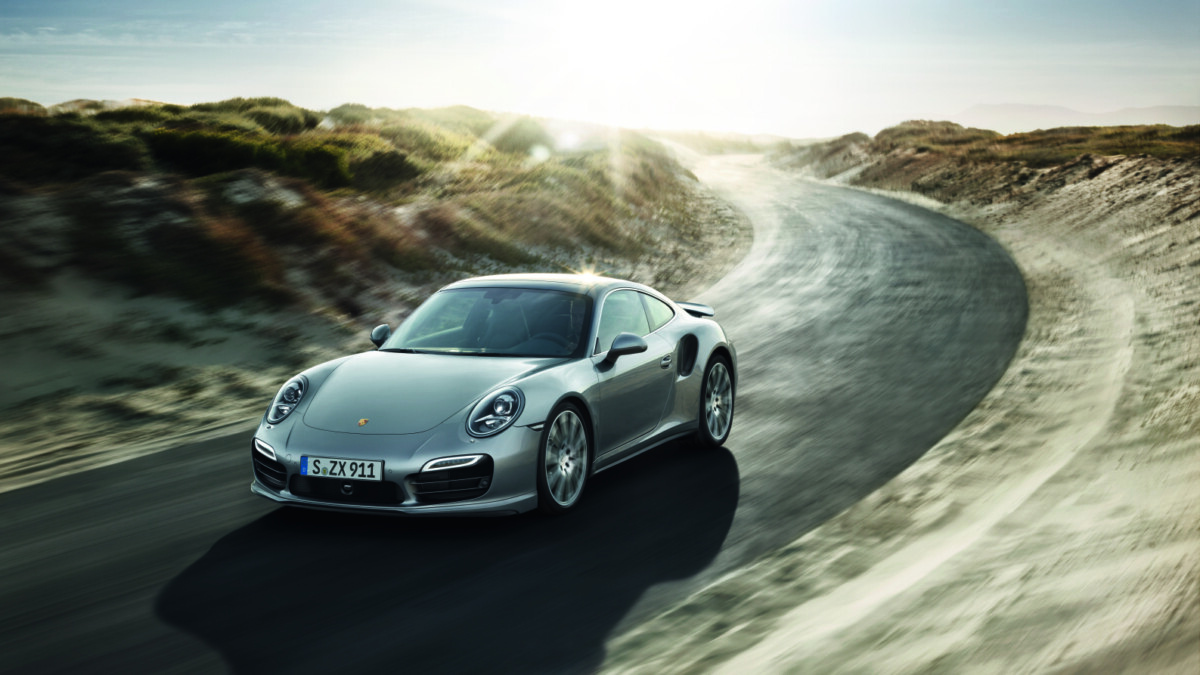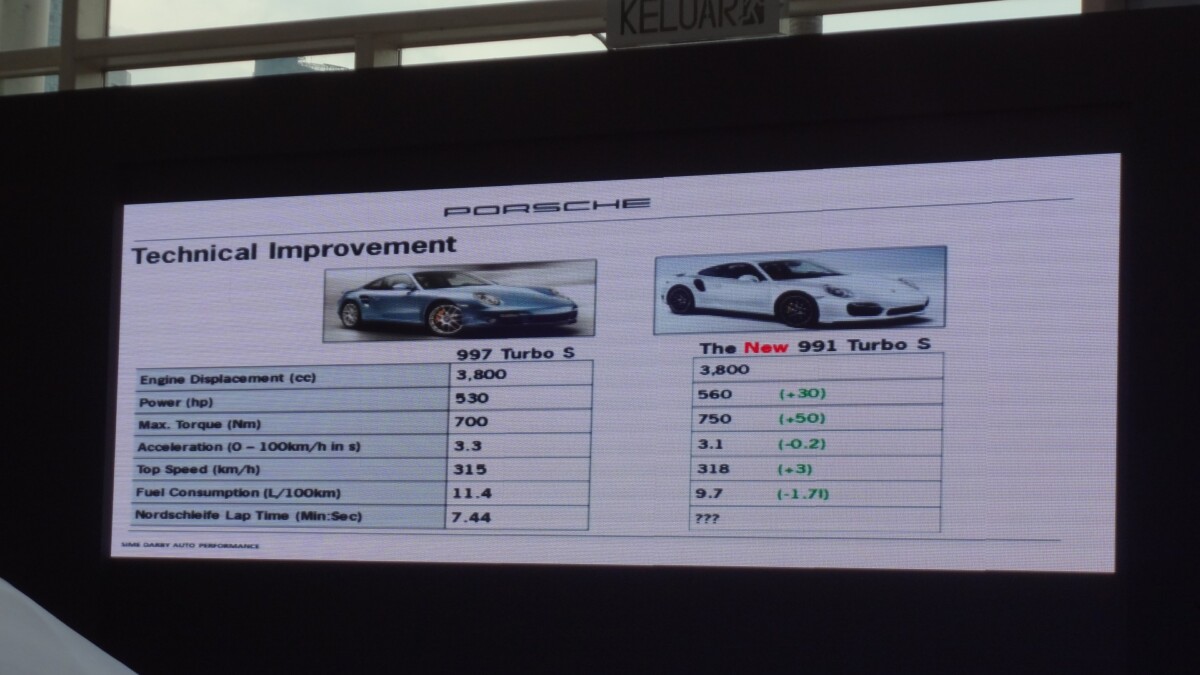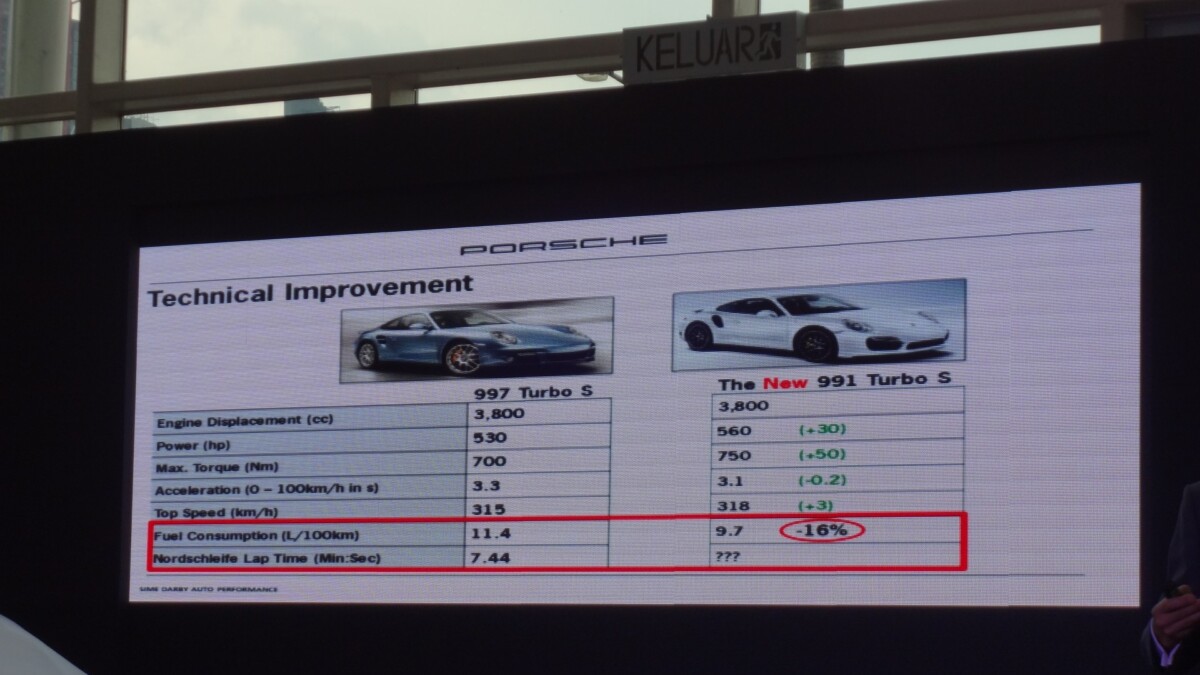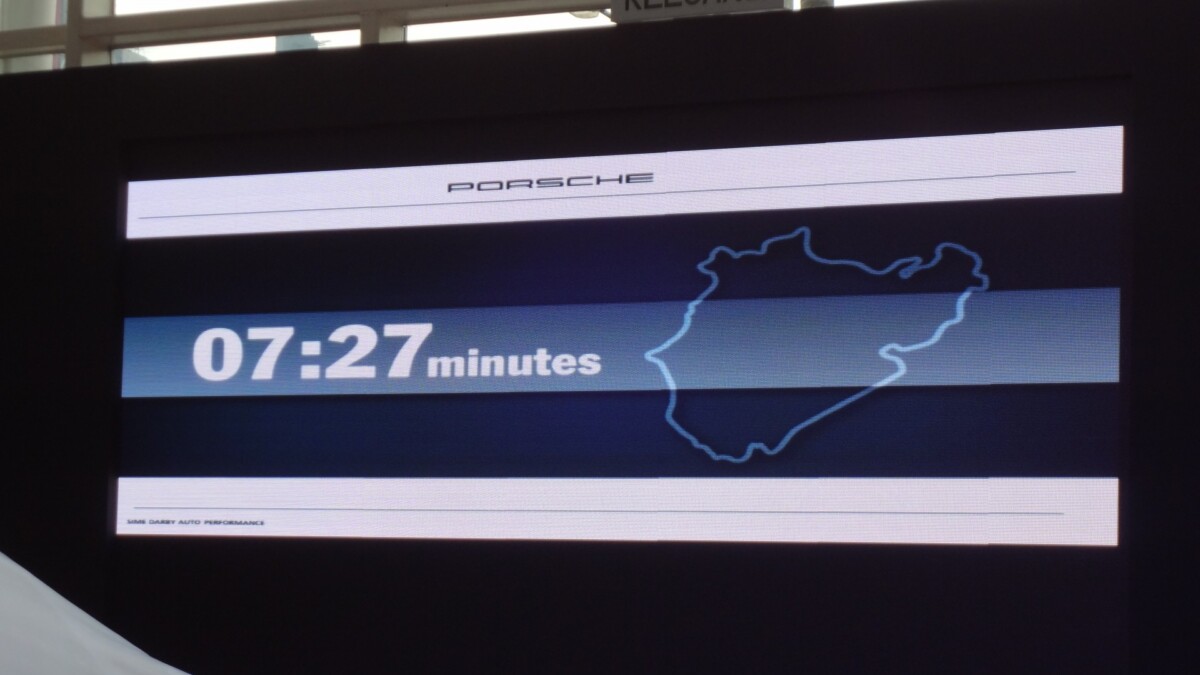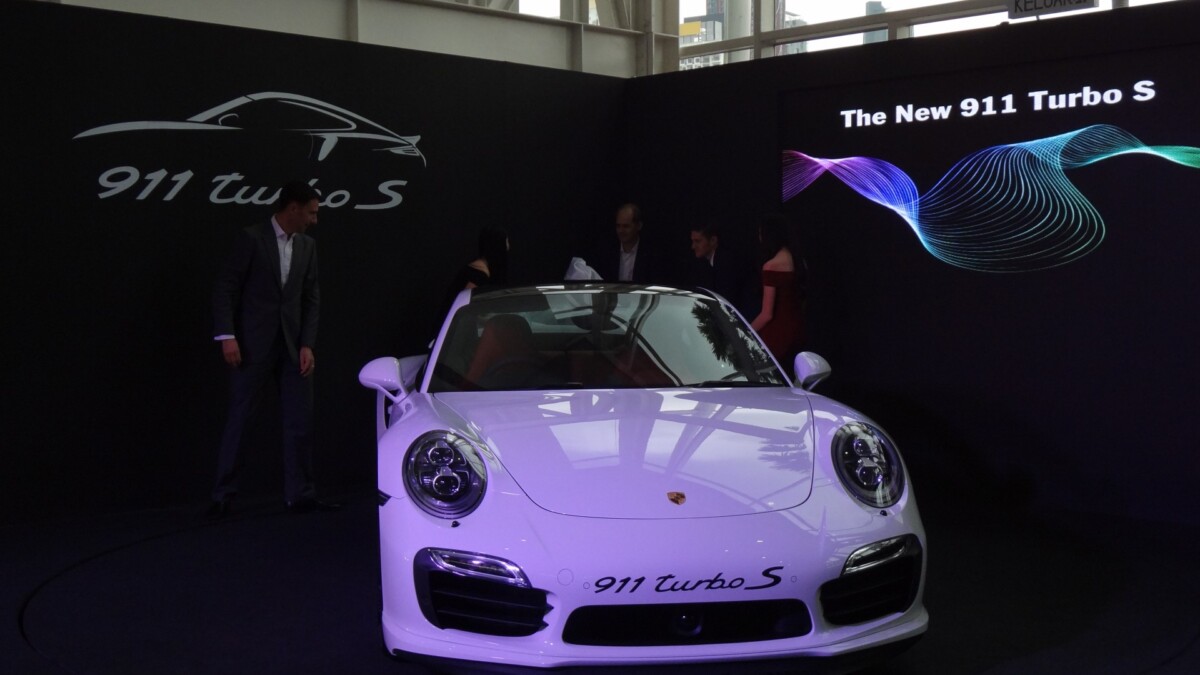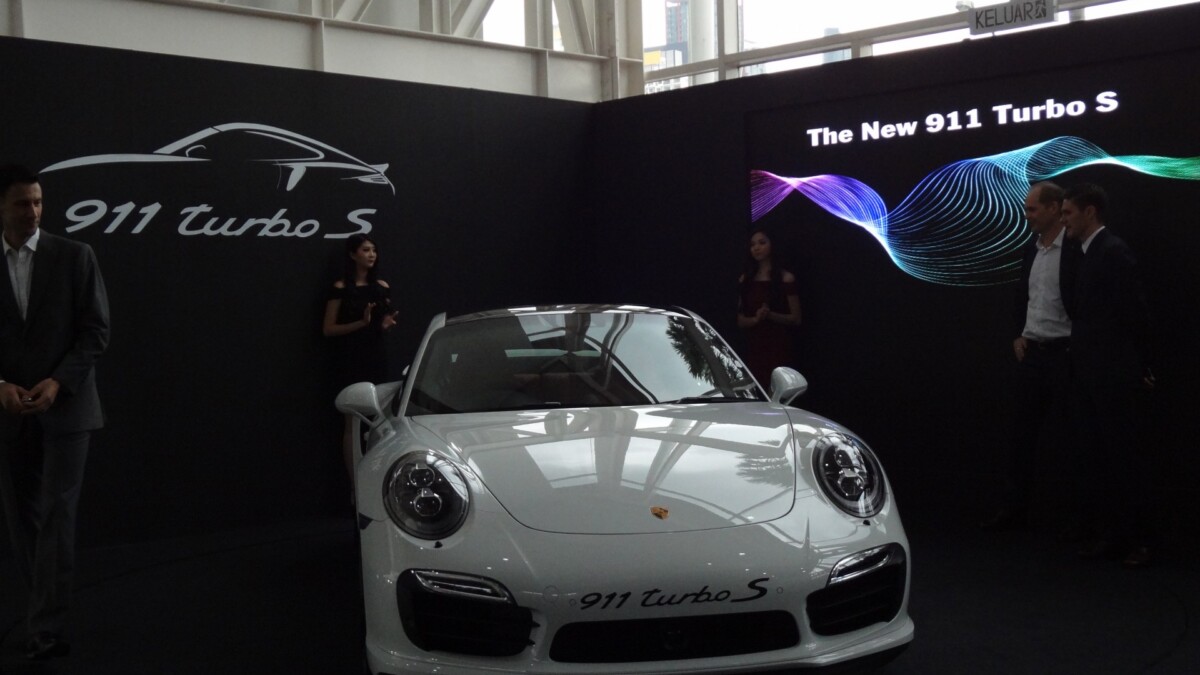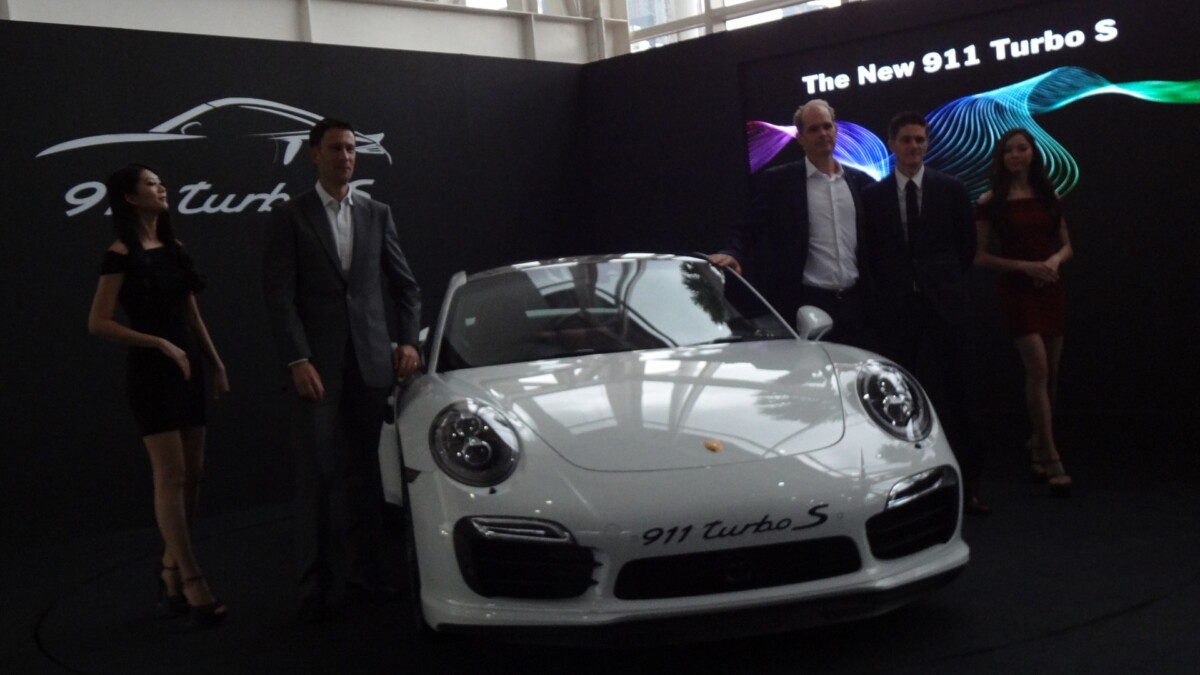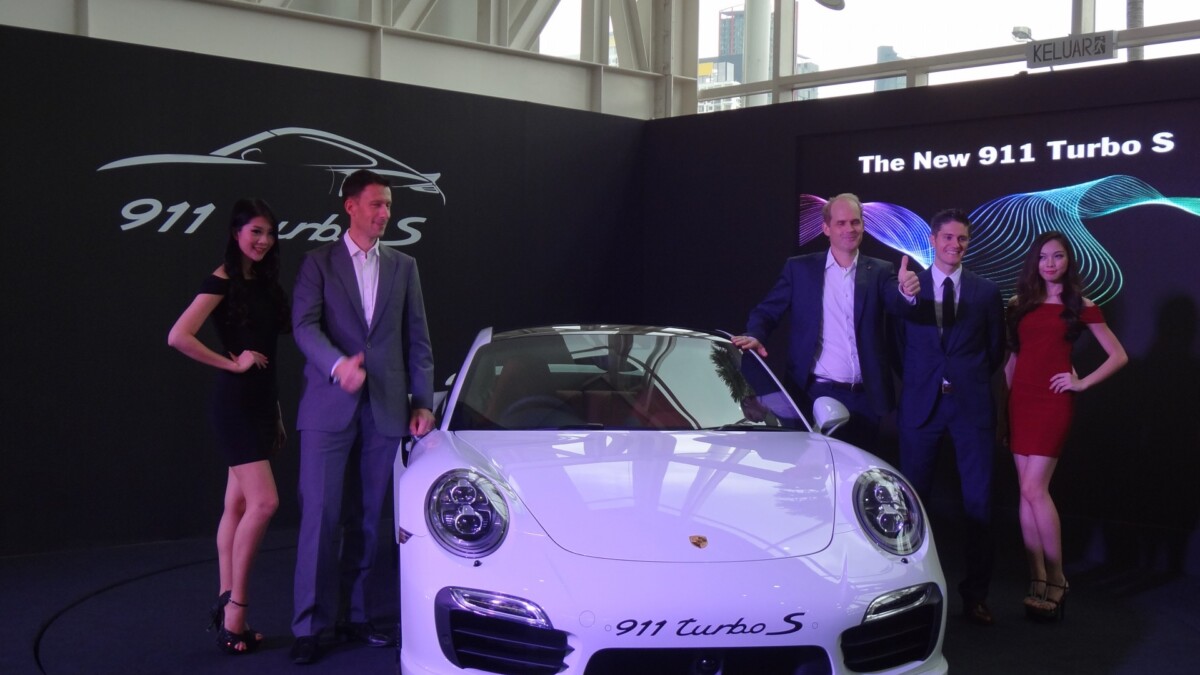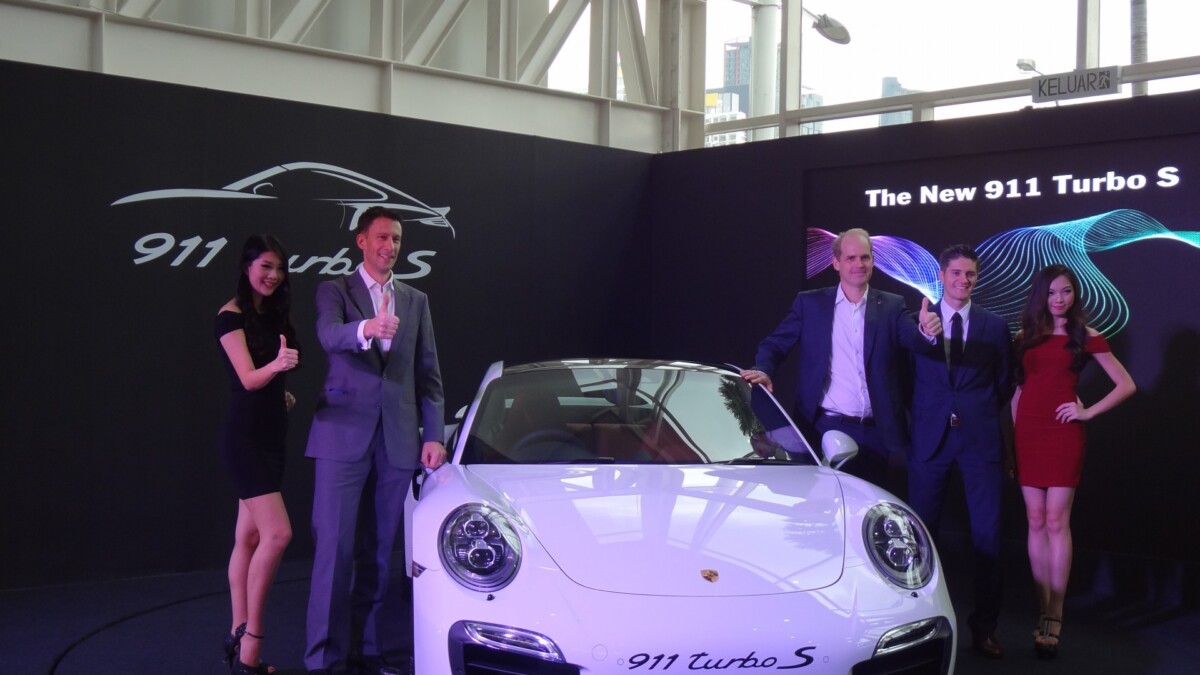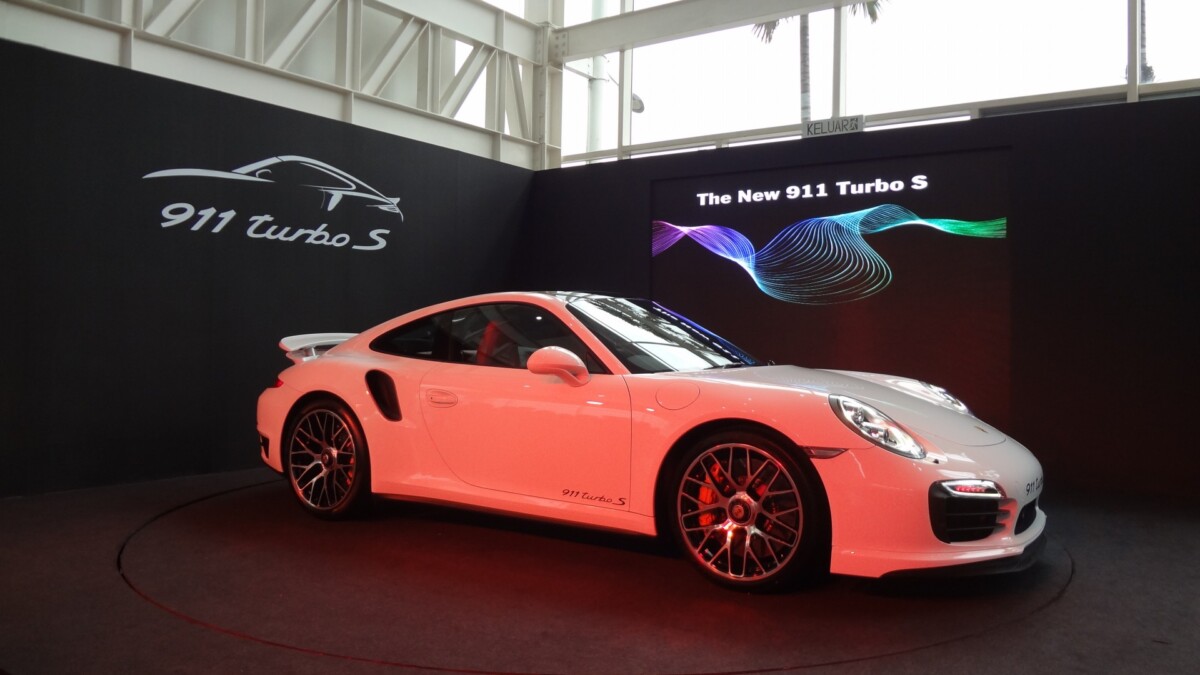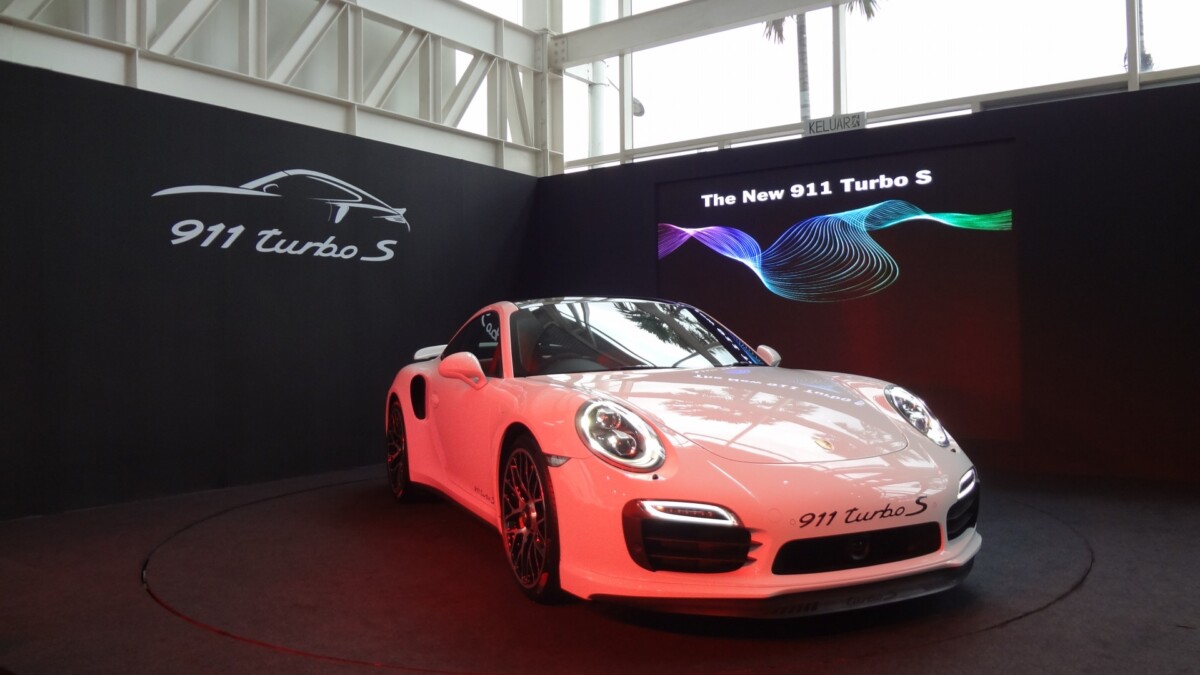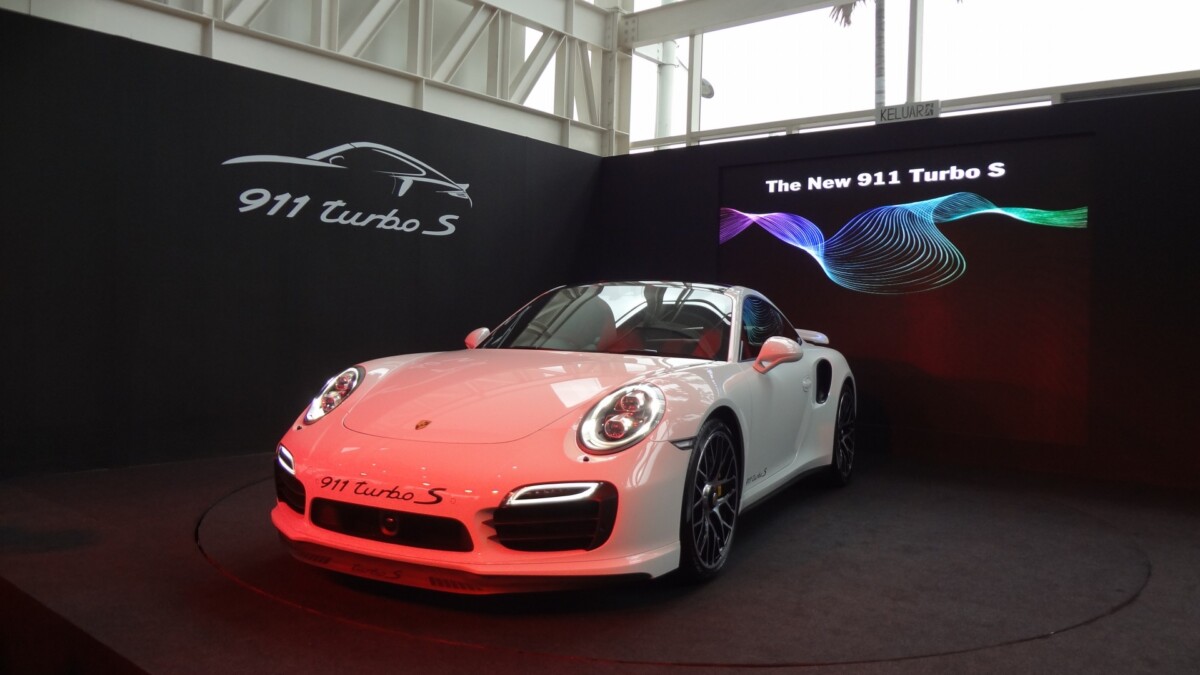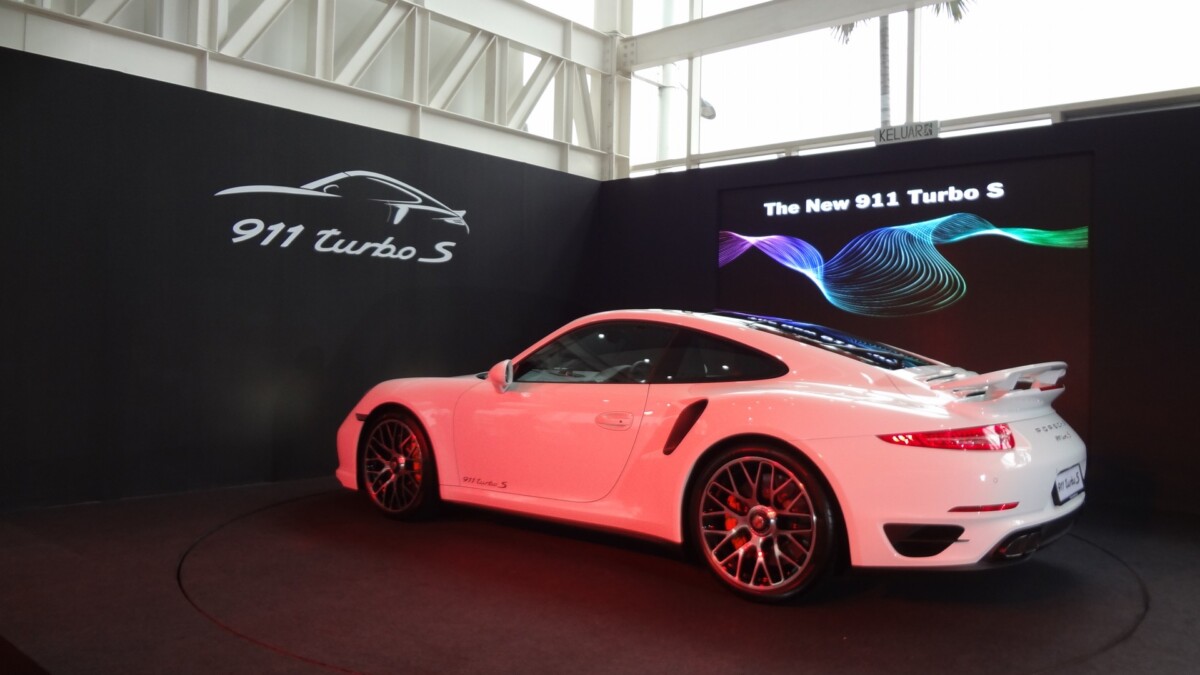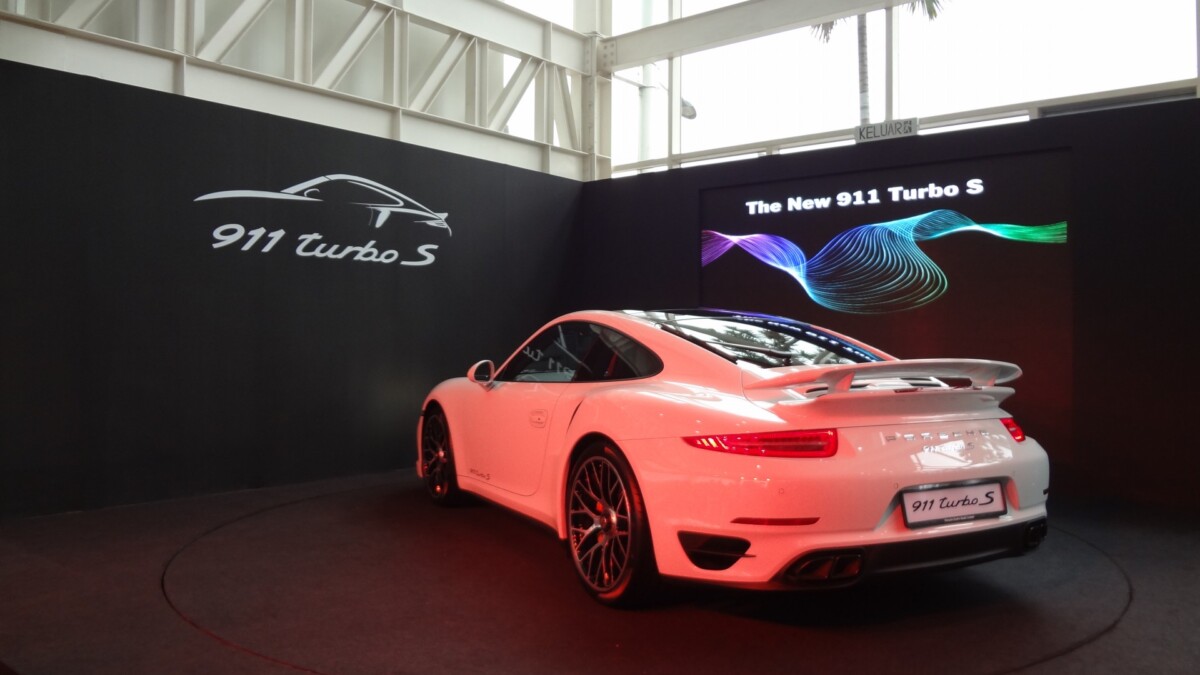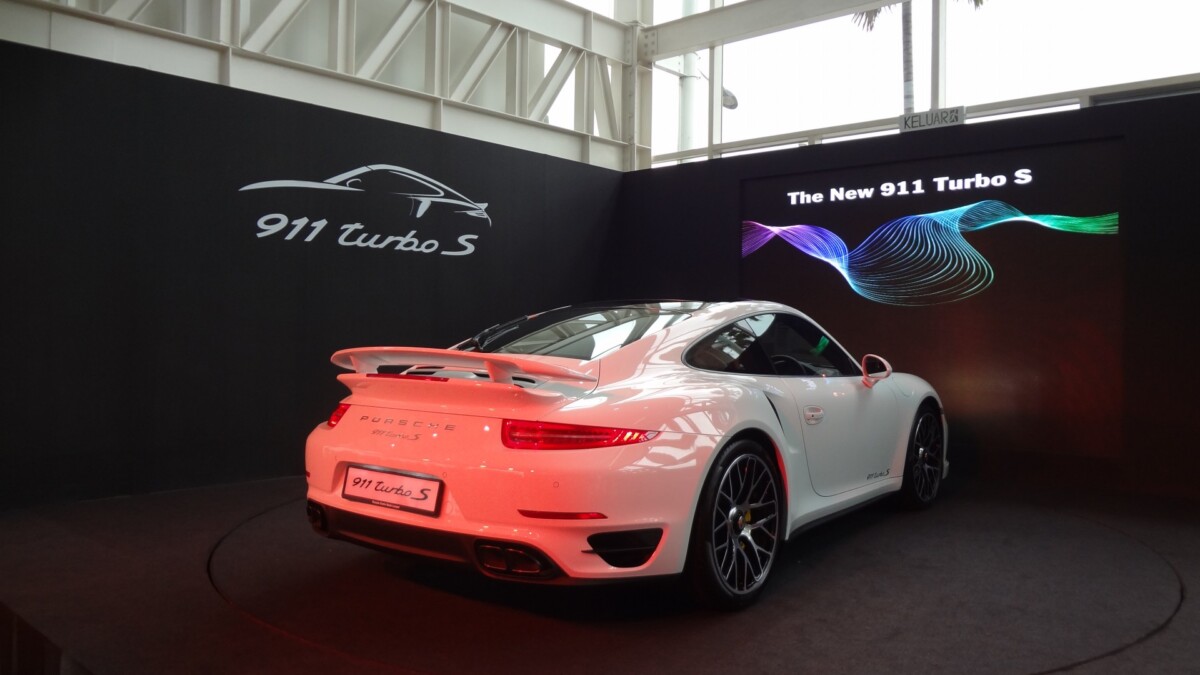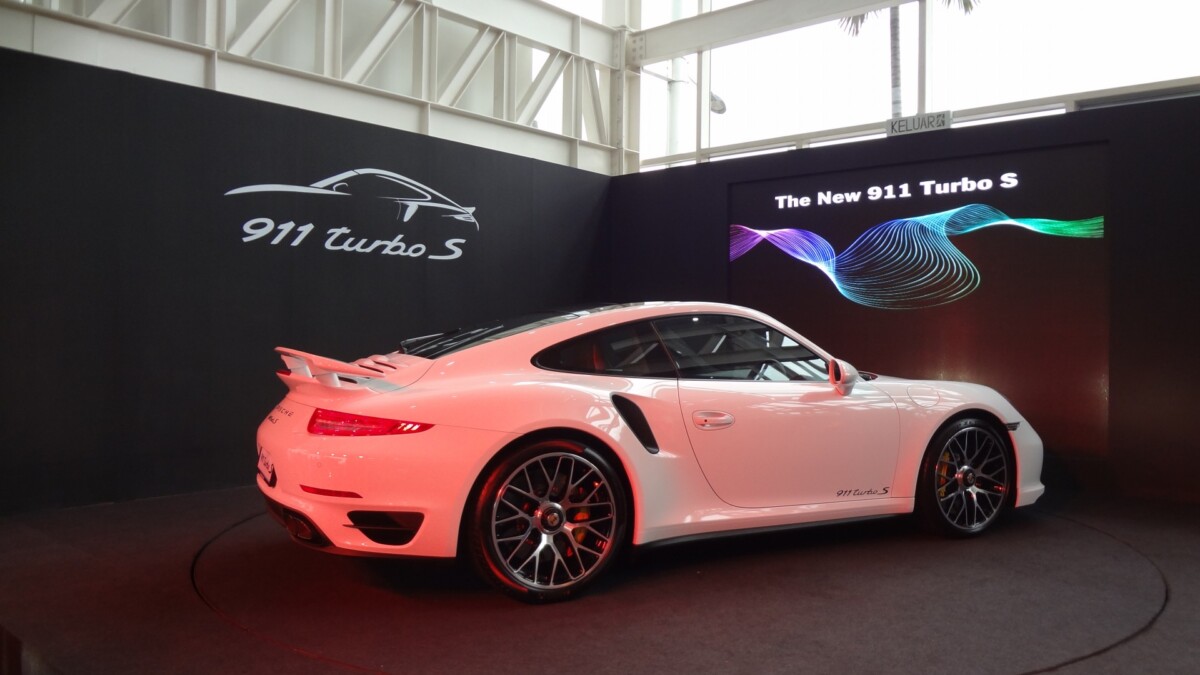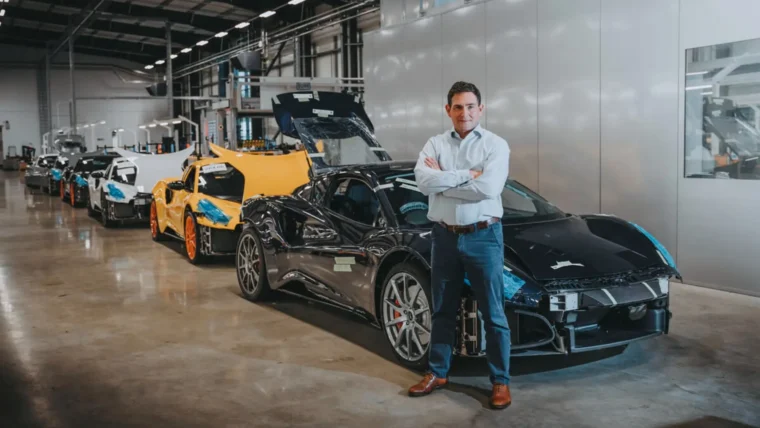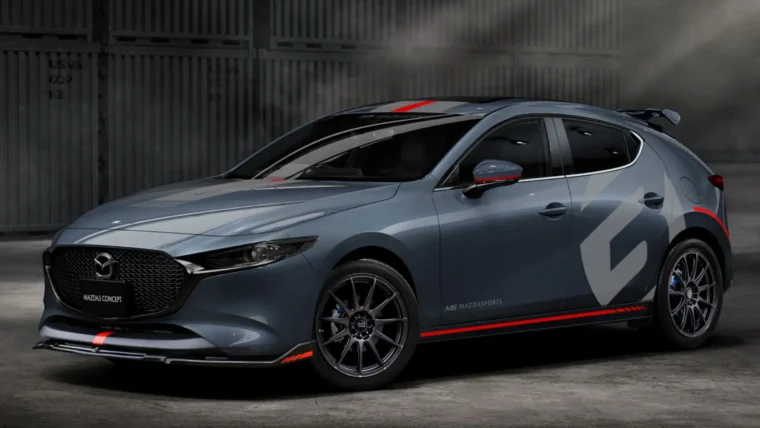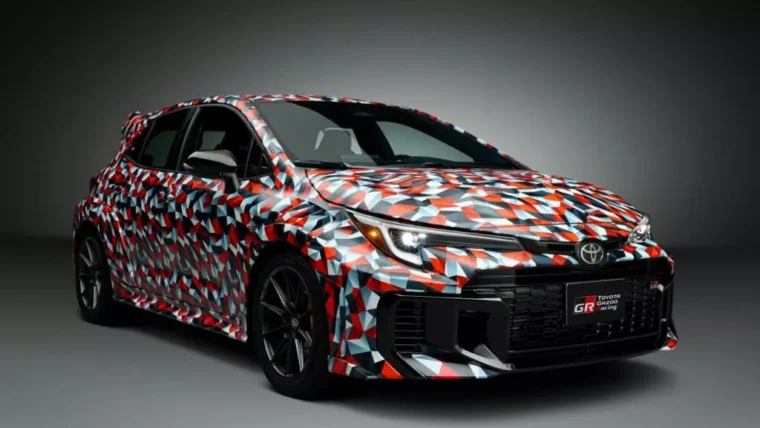It’s simply stunning. With its longer wheelbase and wider rear track, it cuts a mean profile from whatever angle you look at it. Held at the Porsche Centre in Damansara, Sime Darby Auto Performance (SDAP), the authorized importer of Porsche vehicles in Malaysia, officially launched the new generation 911 Turbo S recently, and seriously folks, it’s probably the best looking 911 yet.
Celebrating the 50 Years of the iconic ‘nine-eleven’ which debuted at the Frankfurt International Auto Show (IAA) in 1974, 40 years later, the Porsche 911 Turbo S is redefining the old adage of ‘race on Sunday, drive to work on Monday’ that the 911 has been so famous for.
Chief Executive Officer of SDAP, Arnt Bayer (above, second from left): “When the first 911 Turbo was showcased in IAA in 1974, the sight of the silver Porsche drew attention from far and wide. On its tailgate, there was a protruding spoiler with air slots and framed by a thick rubber lip. The Porsche 911 Turbo not only attained the peak of cars as the fastest street sports car at that time, it also triggered a genuine turbo boom.”
The unique selling point of the 911 Turbo S has been the extreme spread of its capabilities that range between dynamic performance and efficiency, between exclusivity and everyday practicality. Advanced development of existing systems and the introduction of new active systems are extending this range in such a way that the 911 models have now cranked their top values up a notch in all individual disciplines.
The new Porsche 911 Turbo models are the world’s first sports car to feature adaptive aerodynamics. Based on a unique combination of a front spoiler that can be extended in multiple stages and a rear slotted wing that is adjustable in height and attach angle. The new 911 Turbo S on the other hand, can adapts its aerodynamics shape to the current situation and to the driver’s wishes at the press of the button with Porsche Adaptive Aerodynamics (PAA). This improves driving stability at all speeds with greater day-to-day usability.
New all-wheel drive, active rear axle steering, adaptive aerodynamics, full-LED headlights and up to 560 hp flat six-cylinder engine with bi-turbo charging underscore the role of the new generation 911 Turbo S as a circuit racing car, everyday car and technology platform. Playing an equally crucial role are the entirely new chassis in lightweight design with a 100 mm longer wheelbase and larger 20-inch wheels. The Porsche Dynamic Chassis Control (PDCC) active anti-roll system, which is being offered for the first time in 911 Turbo S, increases dynamic performance even more. This system is standard equipment in the 911 Turbo S, as is the Sport Chrono Package Plus with dynamic engine mounts and PCCB ceramic brakes.
Base price for the new 911 Turbo S in Malaysia will be announced at a later date, but expect it to be in the region of RM1.2-1.3m. Be sure to check out the fantastic video on the new 911 Turbo S on the official Autofreaks.NET Facebook page, and gasp in astonishment at the active aerodynamics which create downforce on both the front (44kg) and rear (88kg) of the car, view it here: https://www.facebook.com/Autofreaks
Here’s a bit more about the new 911 in detail: (More photos in the gallery after the text)
More power, fuel economy improved by 16 per cent
The performance partners in the powertrain area are the further advanced engines and the new PTM all-wheel drive system. The turbocharged 3.8-litre six-cylinder engine with direct petrol injection produces 560 hp (412kW) in the 911 Turbo S. Porsche continues to be the only carmaker to offer two turbochargers with variable turbine geometry for a petrol engine. Power is transferred to the drivetrain via the seven-speed dual clutch transmission (PDK), which now enables an auto start/stop function with engine shutoff and activates earlier during coasting to a stop or coasting function. Together with the new thermal management system for the turbo engine and the PDK transmission, fuel efficiency technologies have reduced NEDC fuel consumption by up to 16 per cent to 9.7 l/100 km.
New all-wheel drive with electro-hydraulic control
For an even faster and more precise power distribution to the two axles, Porsche developed a new all-wheel drive system (PTM) with electronically controlled and activated multi-plate coupling. The system is equipped with a new water cooling function, so that it can direct even more drive torque to the front wheels if necessary. Simultaneously, the optimised interplay of the engine, transmission and all-wheel drive systems takes the new top 911 to even better sprint capabilities. The new 911 Turbo S handles the standard sprint to 100 km/h in just 3.1 seconds and a top speed of 318 km/h.
Widest body of all 911 cars
The new top model displays its performance visually more than ever. The characteristic, expansively wide rear body panels of the new generation 911 Turbo are 28 mm wider than on the 911 Carrera 4 models. It features a nearly level surface, about the width of a hand, between the C-pillar and the outer edge of the car body. Other differentiating characteristics include two-tone forged 20-inch wheels and hub wheel locks on the 911 Turbo S. It is also making an appearance with new full-LED headlights that feature four-point daytime running lights and dynamic, camera-based main beam control.
Rear axle steering sustainably improves handling
The introduction of rear axle steering in all turbo models immensely improves both circuit racing and everyday performance of the two new top sports cars. The system consists of two electro-mechanical actuators instead of the conventional control arms on the left and right of the rear axle. The steering angle of the rear wheels can be varied by up to 2.8 degrees, depending on vehicle speed. At speeds up to 50 km/h, when the front wheels are turned, the system steers the rear wheels in the opposite direction. This actually corresponds to a virtual shortening of the wheelbase by 250 mm, which gives the 911 Turbo S an unrivalled performance in bends. The system lets the car turn faster into the bend and offers more dynamic steering response. This noticeably simplifies manoeuvring and parking.
At speeds above 80 km/h, the system steers the rear wheels parallel to the turned front wheels. This is equivalent to a virtual lengthening of the wheelbase by a significant 500 mm and gives the sports car tremendous stability, especially at high speeds. At the same time, the steering input by the driver leads to significantly faster build-up of lateral force at the rear axle, which initiates the change in direction more spontaneous and harmoniously.
Active aerodynamics improve efficiency and performance
Porsche developed an active aerodynamic system on the new 911 Turbo models for the first time. It consists of a sturdy, retractable three-stage front spoiler, whose segments can be pneumatically extended, and a deployable rear wing with three adjustable wing positions. This makes it possible to tune the aerodynamics of the 911 Turbo to fulfil driver wishes for either optimal efficiency (speed position) or top dynamic performance. In the performance position, all segments of the front spoiler are fully extended, and they generate considerable downforce at the front axle. Similarly, the rear wing is extended to its maximum height with the greatest angle of attack. This also generates more downforce at the rear axle.
New interior with high-end features
The interior was completely redesigned in both 911 Turbo models, and it builds on the 911 Carrera family. The S model is particularly well equipped, offering such features as an exclusive interior in a black/carrera red colour combination and sport seats plus with 18-way adjustment and memory. In addition, the seat backrest shells are leather upholstered with double cap seams and various elements in carbon look. Like on the previous models, the Bose sound system is installed as standard; for the first time, a Burmester system is also available as an optional feature. A radar-controlled cruise control system, camera-based road sign recognition and speed limit recognition are other new options being offered.
Other posts by Chris Wee

